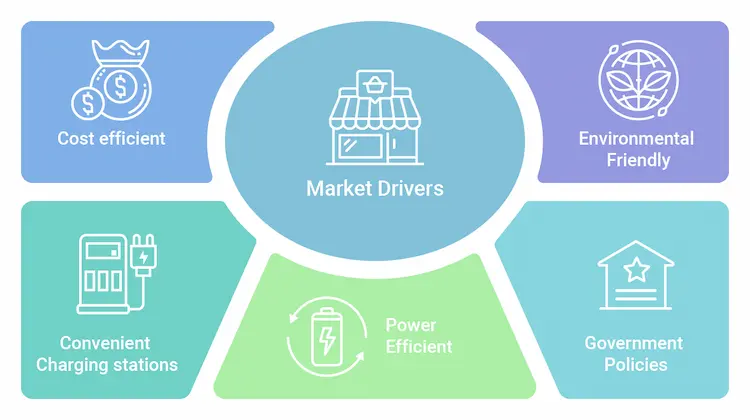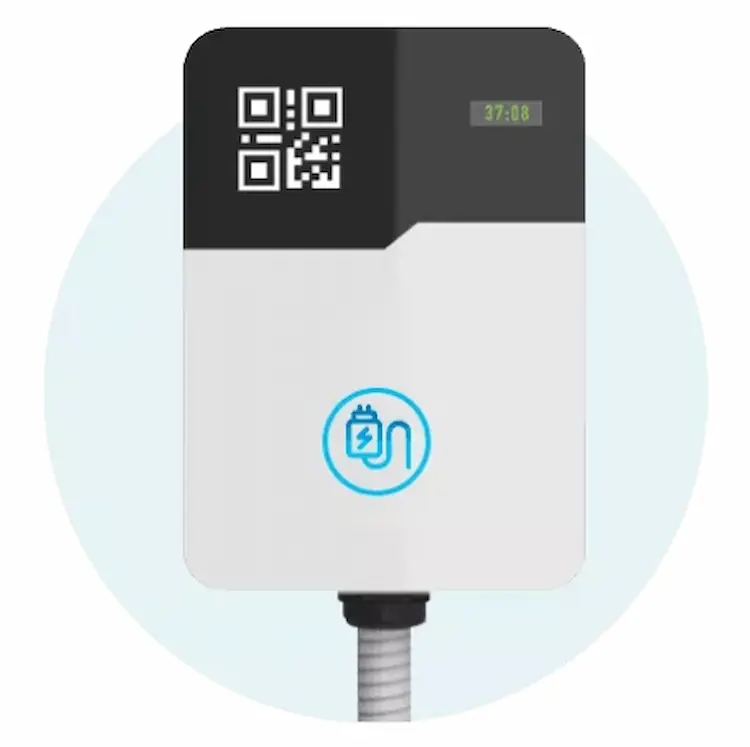The increasing want for environmental-friendly automotive is a vital element for the development of the Electric Vehicle charging stations market. Inventions and significant financial contributions in developing the EV charging system are also visualized to stimulate the development of the international market. As opposed to this, the high cost of DC fast charging piles is expected to decrease the development of the EV charging infrastructure sector worldwide.
Solar photovoltaic charging piles for electric cars may satisfy the growing demand for electricity by electric cars in the future. This technology majorly concentrates on financial and technological practicalities.
Additionally, the solar photovoltaic equipped electrical cars possess contamination mitigation features for Carbon dioxide, nitrogen oxides, and other pollutant gasses. These market EV charging infrastructure tendencies are anticipated to produce immense possibilities for expanding the international electric vehicle charging station market.
The worldwide electric vehicle charging stations market was speculated to rise from $5.8 billion to $6.79 billion from 2020 to 2021, with a 17.1% internal rate of return.
This increase resulted from corporations recovering their functionality and adjusting to the current mode of things while recuperating from the Corona Virus effects that resulted in the shutdown of economic ventures. In 2025, the economy is anticipated to be $20.49 billion with a 31.8% internal rate of return.
The EV charging pile industry incorporates the provision of charging services. Charging stations offer their services in the form of direct and alternating current charging. Alternating current charging piles are subdivided into grade 1 charging stations (120V) and grade 2 (240V), while grade 3 charging stations are Direct current with 480V power.
Market Drivers
Various factors stimulate the electric vehicle charging stations market. Such factors, to an extent, correlate with the benefits Electric Vehicles present to the world today. These drivers include:
1. Cost efficient
The low operation cost for charging an electric car, which is more cost-efficient compared to filling up a fuel car. Statistics show that using an electric car instead of a fuel car can save a lot of money, accumulating to almost $632 per annum. For this reason, more people are compelled to buy Electric Vehicles, hence boosting the demand for electric vehicle charging stations.
2. Environmental Friendly
Electric cars also have zero percentage carbon emissions. This is a great advantage compared to fuel vehicles, which, as stated by the Environmental Protection Agency (EPA), emit approximately 4.6 metric tons of CO2 yearly for every 22-miles/gallon. Moreover, if reusable energy powers the electric vehicle, the carbon footprint will decrease even further.
Contrary to the belief that the manufacture of batteries incurs a considerable carbon cost, electric cars generally generate insignificant amounts of carbon dioxide. This propels most governments to be supportive of the production of new EVs and EV charging stations.
3. Convenient Charging stations
Home charging stations are considered by many as very convenient since they eliminate the need to go to the gas station every day. They are also compatible with the owner’s vehicle and provide a chance of charging overnight while the car is parked in the garage. An increasing number of people find this to be advantageous and therefore shift to EVs.
4. Power Efficient
Electric Vehicles utilize the power that they produce more efficiently compared to fuel-powered vehicles. Here, the portion of power applied in propelling the car determines efficiency. For gas-powered vehicles, only 15% of the power produced is applied in propelling the car. On the other hand, Electric vehicles can produce 70% efficiency, saving a lot of energy.
5. Government Policies
Government policies play a huge role in the booming of the EV industry. In the Asia-Pacific region, the EV charging station market is anticipated to expand at a 34.5% compound annual growth rate by 2026 with an income of $5,762.6 million. Within Asian countries, Subsidies from the government for Electric Vehicle programs are among the compelling elements supporting the EV charging station market.
The Indian government intends to construct about 5,000 Electric Vehicle charging piles. Several initiatives by various Asian governments, e.g., Korea, China, Japan, etc., are yet key elements for expanding the international charging station market.
Furthermore, financial and non-financial motives and government grants have been instrumental in the diverse establishment of the Electric Vehicle ecosystem. This will ultimately expand the Asian economy.
In the United States of America, the states with the greatest rank of charging piles are Washington DC, Hawaii, Vermont, Colorado, and California.
Market Restraints
1. Long recharging time
While refilling a gas tank can be done in less than five minutes, recharging an electric vehicle battery can take quite a long time (approximately 12 hours) to charge fully. This may not be a challenge to the majority of EV owners as they mostly cover a lower distance than the limit of their electric cars.
However, EV owners who require to cover long distances often must cope with the long charging hours. This is a turn-off for some car buyers that may cause their preference to shift to fuel-powered vehicles.
2. The high Purchasing cost of EV charging systems
Since EV technology is not yet fully developed, the production rate of EV charging systems is far less than that of fuel. Furthermore, car-fueling stations are more convenient compared to EV charging stations, hence making them cheaper.
Also, the cost of manufacturing, production and distribution of EV charging is an expensive endeavour that can go up to billions of dollars. This may explain the consumers and governments’ reluctance towards EVs.
The substantial price gap may prompt many EV consumers to consider buying fuel-powered cars, hence affecting the Electric vehicle charging station business negatively.
3. Low full-charge driving range of EV charging compared to fuel
Battery and charging advancements over the past few years have helped increase the driving range of electric cars. Electric cars can now go for over 200 miles on one charge.
This range, although effective, is no match for fuel, which can brag for powering vehicles for over 400-mile range per full tank. Long-distance drivers are therefore more likely to go for fuel-powered vehicles. The outcome of this is negative on the EV charging station industry.
The rise in electric vehicles entry into the market
As a mineral, gasoline is an exhaustible energy source, and it is expected to deplete in the future. For future sustenance of the automotive industry, the use of substitute sources of fuel is quite essential. This is where electric cars come in handy. EVs are environmentally friendly and still more economical than gasoline, making them the perfect substitute. Electric vehicles transform above 50% electricity from the power source to directly rotate at the wheels, while gasoline cars are only capable of transforming a maximum of 21% of their power. Following the hype in the cost of gasoline-based fuels, the demand for economical vehicles has risen lately. This is due to the long-term exhaustion of gasoline and the increased trend of fuel companies to maximize their profits. Therefore, these situations increase the demand for more reliable, fuel-efficient innovations, hence the rise in the need for electric-powered vehicles. Examples of the chief Electric Vehicle charging station market companies are:
● MOKOSmart
● Tesla
● Eaton
● ChargePoint
● ClipperCreek
● ABB
● Pod Point
● International Pod Point
● General electric
● Leviton Manufacturing
● Rittal GmbH
How Corona Virus has affected the Electric Vehicle Charging Station Market
The Corona Virus outbreak has induced an extensive financial recession. Most nations enforced stern measures to control the virus, hence resulting in the closure of production companies and interruptions in the chains of logistics and output plans.
The international technological provision chains have also been substantially impacted. The financial downturn has interfered with the vehicle manufacturing sector, resulting in a fast decrease in automobile sales. In 2020 the automobile business suffered a reduced income of almost 20%.
Moreover, changes in customer purchasing trends caused by indecisive situations adjacent to the disease are foreseen to provoke critical impacts on the development. At the moment, money shortage has already impacted vehicle dealer sales and is soon anticipated to be worse.
The income made by Electric Vehicle charging station corporations in 2021 has dropped by roughly 12% because the demand for the EV charging sector has been majorly affected.
Important acquisitions for bringing EV charging infrastructure into service have been stopped, following the impact of government limitations on producers of Electric Vehicle Supply Equipment globally. E.g., In the United Kingdom, Rolec Services discontinued the construction of EV charging piles as a result of the COVID-19 lockdown.
These events have had adverse effects on the international EV charging stations market, considering the high EV charging stations cost on startup.
Nonetheless, the majority of the local authorities from impacted areas undertake infrastructure reconstruction to hasten financial restoration. Governments are spending capital on charging stations by investing directly in public EV charging stations and offering subsidies for constructing private charging stations in residential areas and work buildings.
Generally, the Coronavirus widespread has majorly shocked the Electrical Vehicle and the Electric Vehicle Supply Equipment industries.
What are the Government actions to promote the market demand for Electric car charging infrastructure?
Governments intentionally emphasize the migration from fuel to electric vehicles as a long sustaining transportation plan, using developments in electric automobile technology. Taking into account the eco-friendly advantages Electric Vehicles might provide, authorities continue to give inducements and grants to invest in Electric vehicles and charging stations.
For a good electric vehicle system, charging stations play a major role. Many states give financial assistance for the development of charging infrastructure to cater to the rising number of electric vehicles.
A good example is Norway which has launched a widespread charging network to promote the transition to Electric Vehicles. Its authorities intend to install EV quick charging piles at intervals of every 31 miles.
Significant fiscal incentives were initiated to ensure the cost of establishing EV charging systems including vehicle purchase and tax rebates from as early as the late ’90s in the United States and Norway.
The gradual tightening of fuel has factored in the augmented role of EV charging systems in China. This has yielded a stable increase in fuel prices and fuel-driven vehicles. This also aids in less emission of CO2 by 85% according to e-government reports.
Such efforts intended to improve the EV charging network contribute majorly to boosting the expanding electric vehicle charging station market.
Fundamental discoveries following the research on Electric Vehicle Charging Stations Market:
Mode of connection
This is the connection of electric vehicles to an electrical network. Four modes include;
Mode one: This is a direct connection of the electric vehicle to electric sockets without safety systems. This is recommended for electric scooters and bikes.
Mode two: This uses a specific safety system between the point of connection to the network and the car being charged. Best applicable for both domestic and industrial sockets.
Mode three: This involves the power supply system being constantly linked to the electrical grid. Applied to automatic charging systems in alternating current.
Mode four: It requires your vehicle to connect to a cable via the current external converter. This mode makes the electric charging stations more voluminous as compared to those using the other modes of connection.
Despite that, wireless EV charging stations are likely to develop at the greatest compound annual growth rate over the base period.
The significant development of this division is primarily attributed to:
● Boosting government schemes for establishing Direct current charging stations,
● Counterattack the procurement of DC fast-charging piles,
● Acquiring finances from vehicle manufacturers for advancing fast-charging piles to cater for their long-distance Electric vehicles and capability of DC chargers to deliver quicker charging in comparison with Level one and Level two charging piles.
Component
All EVs have basic components installed for optimum functioning including:
1. A traction battery: This is the energy-storing structure in DC electricity form.
2. Power Inverter: This changes the DC on the battery into the alternative current (AC) which is used by the electric motor.
3. Controller: It acts as a regulator of electric energy from batteries and inverters which distribute it to electric motors.
4. Electric traction motor: This executes the task of thrust and revival of electric energy on a typical basis.
A vital discovery was made in the component division whereby it delivers two charging methods (conventional and fast charging) which may determine the duration of an EV to gain a full charge. The hardware section covered the greatest portion of the EV charging stations market in 2021. The bigger portion of this section is primarily assigned to:
● Creating advancements sustaining the transformation to electric adaptability
● raising demand for EV charging piles in all economies, and
● appealing monetary and non-monetary inducement strategies for establishing production plants of EV charging piles and associated constituents.
Nonetheless, the software section is foreseen to develop at the greatest compound annual growth rate over the base period.
Mode of mounting
The main forms of mounting are wall mount and base mount. The wall mount section covered the greatest portion of the 2021 electric vehicle charging stations market. The bigger portion of this section is primarily assigned to:
● the cost-efficiency of the chargers,
● simple fitting approach, and
● Several financial and non-financial inducements to owners of the property and administrative corporations for the enhancement of Electric vehicles charging system.
Other examples of these mounting systems include the four-point mounting and the pendulum mounting. The four-point mounting may be more popular than the latter as it’s designed for EVs that are exclusive for the electric drive only. However, the wall mount section is the preferred mode for most EVs.
Type of vehicle
According to the type of vehicle, the electric vehicle charging stations market 1 is categorized into; public transport vehicles, light company cars, heavy company cars, and motorbikes/ scooters.
The light company cars section is anticipated to develop at the greatest compound annual growth rate over the base period. The fast expansion of this section is primarily meant to:
● Creating recognition concerning the function of electric cars in minimizing discharges
● Raise electric car’s demand to minimize car emissions and strict administrative laws and guidelines on car emissions.
End-user
In the end user section, the Electric Vehicle charging pile market is divided into company Electric Vehicle charging stations and domestic Electric Vehicle charging stations. The company EV charging stations division covered the biggest portion of the electric vehicles in the 2021 charging stations market. The bigger percentage in this section is generally meant for:
● the rising amount of Electric Vehicle charging piles in communal areas like malls, hotels, and car parks,
● state actions for the establishment of communally available charging stations.
Moreover, this section is anticipated to develop at the greatest compound annual growth rate over the base period.
Geographical location
Location-wise, the EV charging pile market is divided into five main areas: APAC, Europe, Iberian America, USA, and the Mideast & Africa. The APAC (Asia-Pacific) territories are predicted to cover the most considerable percentage in the 2021 electric car charging pile market. The significant portion in this area is mainly as a result of:
● The rising demand for EVs in states like Japan and China
● Increasing state actions to suppress gas discharges that are assured to raise the endorsement of EV and related charging systems, and current financing by different states for a robust charging system employed in communal facilities
Overview of the near future market predictions in accordance to 2020 market review
For DC charging stations
The DC fast charging piles market holds the most significant portion of the electric vehicle charging station market. It is expected to record a profit of around $10,700 million in late 2026, expanding at a compound yearly growth rate of 34%.
The most recent inventions and considerable financial contributions in the innovation process by chief participants are expected to enhance the international market development. Moreover, worldwide adoption of valid power machinery is presumed to promote the want of China electric charging stations.
For AC charging stations
The AC charging piles market is expected to record a profit of around $7,900 million in late 2026, expanding at a Compound annual growth rate of 36% in the base duration.
The main advantage of AC charging piles is that they can be affordably transferred over prolonged ranges. They can execute a risk-free and governed charging process. Besides, AC chargers can charge electric cars at different rates. These essential elements are expected to enhance the international market expansion.
The measure for the level 1 Electric Vehicle charging system (120V) market is expected to create an income of $6,766 million in late 2026, expanding at a Compound annual growth rate of 33.7% over the base duration.
The estimate for the level 3 electric vehicle charging station (300-600 V) market portion is expected to record an income of around $5,688.2 million in 2026, expanding at a Compound annual growth rate of 36%. In the communal charging domain, Level 3 charging piles can save more time and increase efficiency for consumers in a hurry.
The Level 3 type needs an AC to DC power alternator to produce DC power from an AC charger. In addition, to adhere to administrative rules, electricity input is required to undergo power factor correction.
By 2026 Private EV charging system market is expected to record an income of $10,855.9 million, expanding at a compound annual growth rate of 33% over the base duration. Ensuring no carbon emissions is among the critical considerations for the expansion of the international market.
Moreover, EV owners find it more reliable to set up charging piles in their homes; this too is expected to stimulate the international market. By 2026, the communal charging segment is anticipated to create an income of $7,733.0 million, expanding at a 36.7% compound annual growth rate over the base duration.
Major EV charging station companies with the latest tech for innovating their Electric Vehicle charging stations have more potential to achieve in the fast-growing EV charging station market. In the long run, this will boost technological advancements in other fields and the world’s economy in general. Such companies like Mokosmart are implementing innovations of EVs to grow China’s economy whilst achieving fast market growth.
Mokosmart Ev Charging System Solutions
MOKO EV Charging System offers a reliable strategy for developing the perfect solution to your EV charging needs. Whether it’s in your office, mall, shop or home setup, we can install your EV charging station for your convenience in no time. Our company’s charging hardware are known to be:
● Flexible for all charging modes and cable versions.
● Accurate metering and energy monitoring.
● Easy installation of EV charging systems.
● Expandable and customizable charging units.
Our Main Charging stations
1. Single Socket Unit
Has a Rated Operating Power Supply of 100-240VAC, 50/60Hz which is supplied by Channel 1 with a maximum current of 16A and packs a massive power of 3.3KW.
It’s power accuracy of ±0.5%-±1% only adds to its outstanding reliability. Furthermore, your connectivity is sorted with a wireless standard Bluetooth version 4.2.
2. Two Socket Unit
An obvious upgrade from the single socket unit, it’s packed with impressive stats including:
Rated Operating Power Supply of 100-240VAC, 50/60Hz courtesy of Channel 2.
The maximum current of each channel is 16A with the power of 3.3KW.
3. Charging Station with 10 Channels
This is a true powerhouse in the EV Charging Industry with an impressive rated operating power of 100-240 VAC, 50-60HZ supplied through ten channels. Each channel is capable of supplying 2.7A currents with a power of 600KW. Its maximum power is a colossal 4 KW. An impeccable charging system for your money’s worth.
We offer great customer services and authenticity during provision of our products.
Electric vehicle charging station market in different countries
The development of charging piles in foreign countries is relatively mature: the United States, Japan, Israel, France, Britain and other countries have started to build their own ev charging facilities, mainly with charging piles.
1) The United States
US is a vast country with strong independence of each state. States differ from each other in terms of electric vehicles and their charging facilities. California, Virginia and other states have carried out the construction of charging facilities. Most of California’s construction, by the company with “good space project” in Oakland, California north of San Francisco, and SAN jose city government construction, in 2012 in the city’s residential areas, shopping malls, parking lots, and government buildings all pile installation charge, for the electric car driver for car battery at any time. The company will also build battery replacement stations in the areas so that long-distance drivers can replace their batteries at any time, with a total investment of $1 billion. In addition, SolarCity has built five charging stations on California’s 101 Highway. Each charging station can provide 240V and 70A quick charging service, which can fully charge Tesla’s pure electric vehicles within 3.5h.
2) Japan
As of 2009, Japan had more than 100 charging stations, 60% of which were concentrated in Tokyo. The Japanese government says it will build more than 1,000 charging stations within three years in an effort to popularize electric cars. The Tokyo Electric Power Company (TEPCO) will take the lead in infrastructure construction, with more than 200 charging stations set to open in Tokyo in 2010. The number is expected to rise to more than 1,000 in three years. Charging piles are more common in Tokyo and can be seen along building roadsides. Kanagawa Prefecture, near Tokyo, plans to put at least 3,000 electric cars on the road within five years and has promised 150 quick-charging stations. Japan’s central government has endorsed the technology, choosing cities to pilot ev charging programs. The project will involve installing electrical outlets in pay car parks, supermarkets and restaurant chains for drivers to use for free.
3) United Kingdom
In the UK, there are already 60 free charging points for cars in The city of London, making it easy for people with electric vehicles to find charging points near homes, offices or busy streets for unlimited charging and parking at a cost of 75 pounds a year.
4) France
In France, electric power enterprises have built a lot of charging stations in cities to power electric cars, and electric cars can also be charged at home. As of 2008, there are more than 10,000 electric vehicles and 200 public charging stations in France. Demonstration applications of electric vehicles are concentrated in municipal, postal, public transport, electric power, sanitation and other public utilities.
5) Israel
On January 21, 2008, renault-nissan motor company and ProjectBetterPlace signed a memorandum of understanding with the Israeli government.They decided to work together over the next three years and promote the market adoption of pure electric vehicles. According to the cooperation agreement,Israel government will be responsible for developing tax incentives for consumers,Renault will be responsible for supplying electric vehicles, while ProjectBetter has already started building its own electric vehicle charging facilities, mainly charging piles.







































